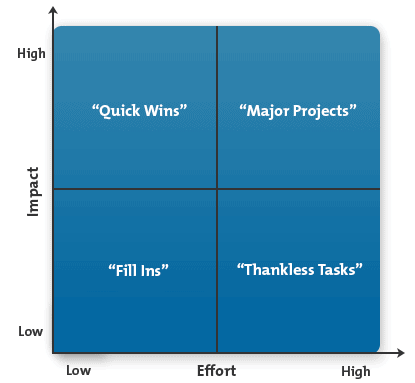

One of the methods that can improve time management is the Action Priority Matrix that aims to prioritize tasks based on their impact and the effort spent on each task. The time management allows designers to improve the efficiency of their time by prioritizing tasks. Step 4: Setup the task priorities based on the type of each task as described on the Activity Priority Matrix.Step 3: Write the tasks based on its score on the Activity Priority Matrix graph similar to the figure above.For example, a task that is high impact and low effort can take a score of (9, 2), a high impact and high effort would score (9,9), and so on. For example, rate each task’s effort and impact from zero to 10. Step 2: Score each task based on the impact and effort spent in each task.Step 1: Prepare a list of all the tasks that need to be completed during a specific period such as the day or the week.In order to apply the Action Priority Matrix, you can follow these steps:

The use of this tool will improve given practice, and you will be able to have a better understanding of the impact of the different tasks and the effort to prioritize them properly. In order to successfully adopt the Action Priority Matrix method, it should be turned from a method to a habit and needs to be adopted over the long term. Out-sourcing these task can help to focus on more important tasks and release from the continuous schedule stress. These tasks are time-consuming and take much time from the more important tasks. Hard logs: these tasks are also known as the “thankless tasks” as they have a low impact but require high effort. This task can be delayed if either a quick win or major project task has arisen, or they can be placed in a less productive time or when the time is available. Therefore, the priority should be organized wisely so none of these tasks directly affect the other.įill ins: these tasks have low impact and low effort, which places them in the third priority after the quick win and major projects. Designers may find it hard to set a priority between both of them as a result. As both types have the same high impact, there is usually a conflict between them. Major projects: these tasks have high impact but they require higher effort or cost comparing with the quick wins they are, therefore, placed in the second priority in the list. It is advisable to place these tasks in the topic of your priorities. As there is a correlation between time and effort, this task may also be characterized with its short deadline or dedicated time to achieve it.

Quick wins: these tasks have the highest impact or return on investment (ROI) possible with the lowest level of effort. Each of the four categories can be defined as below based on its priority: The Action Priority Matrix graph. In this method, the tasks are categorized into four types: Quick Wins, Major Projects, Fill Ins and Hard Logs. The Action Priority Matrix is a graph of two axes the X axis represents the impact, and the Y axis represents the effort spent in the task, both values range from low (in the zero point of the axis) to high as shown in the figure below. Why Do Companies Need a Creative Brief More Than Before?.10 Time Management Tips to Improve Innovation.The Action Priority Matrix is one of the time management tips that can be used to organize the tasks based on those two factors.

The impact can reflect any type of advantages such as profit, market exposure or improved competitiveness, while the effort represents the efforts required or the cost spent to complete the task. Assuming that the time of the tasks is fixed, then two main factors can be used to determine the priority of tasks: impact and effort. In order to achieve better time management for queued work, three main factors can be used to prioritize tasks: time, impact and effort. While many believe they can re-organize tasks in order to gain more time, I always advise my students to master time management instead of depending on procrastination which leads to losing not only clients but also reputation. The majority of designers complain about the lack of time available to achieve their tasks within the required deadlines. This challenge increases when working as a freelancer or working in your own start-up. Unlike regular jobs, designers are required to handle various of tasks on different levels.


 0 kommentar(er)
0 kommentar(er)
